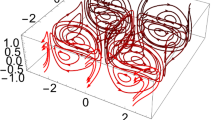Abstract
The focus of this paper is on the development of a novel and simple linear modeling to interpret the (asymptotic) instability conditions for laminar channel (Poiseuille) flow, thereby giving insight on the major length and time scales of the subsequent mean turbulent regime. Although this is an old problem, recently there has been a renewed effort to understand how information on the wall turbulence scalings can be obtained by studying the flow linear dynamics, among other approaches by using the resolvent analysis. Here the classic asymptotic stability analysis is reformulated by means of a pseudo two-fluid model, a central inviscid flow motion, and a wall viscous one, forcing each other on their common interface streamline. The best agreement with the results of the celebrated Orr–Sommerfeld equation is obtained for the interface located around the elevation of the base flow average value, equal to 2/3 times the maximum velocity (frequency scale). It is argued that, in the early stage of perturbations growth, while the mechanism leading to instability (and that is related to the extraction of energy from the base flow via the Reynolds stress), is located near the wall in the critical layer region (already known result for inner length scale), the central region around the flow average velocity (i.e., the outer length scale is of order \({\mathcal {O}}(h)\), with h being the channel half-height) is also deeply involved in the onset of the instability. The initial linear amplification of the wall viscous modes of the present analysis agrees with the major features of the wall functions driving the full turbulent profile, found by means of the resolvent analysis, in the subsequent nonlinear stage.












Similar content being viewed by others
References
Drazin P, Reid W (1981) Hydrodynamic stability. Cambridge University Press, Cambridge
Tollmien W (1931) The production of turbulence. Tech. Rep. NACA-TM-609
Pekeris CL, Shkoller B (1969) Stability of plane Poiseuille flow to periodic perturbances of finite amplitude. J Fluid Mech 39:611–627
Thomas LH (1953) The stability of plane Poiseuille flow. Phys Rev 91:780–783
Stuart JT (1963) Hydrodynamic stability. In: Rosenhead L (ed) Laminar bondary layers. Oxford Clarendon Press, Oxford
Charru F (2011) Hydrodynamic instability. Cambridge University Press, Cambridge
Lindzen RS (1988) Instability of plane parallel shear flow (toward a mechanistic picture of how it works). Pageoph 126:103–121
Baines P, Majumdar S, Mitsudera H (1996) The mechanics of the Tollmien–Schlichting wave. J Fluid Mech 312:107–124
Howard L, Maslowe S (1973) Stability of stratified shear flows. Bound Layer Meteorol 4:511–523
Drazin P (2002) Introduction to hydrodynamic stability. Cambridge University Press, Cambridge
Roy A, Subramanian G (2014) An inviscid modal interpretation of the lift-up effect. J Fluid Mech 757:82–113
Hack MJP, Moin P (2018) Coherent instability in wall-bounded shear. J Fluid Mech 844:917–955
Hall P (2018) Vortex-wave interaction arrays: A sustaining mechanism for the log layer? J Fluid Mech 850:46–82
McKeon BJ, Sharma AS (2010) A critical-layer framework for turbulent pipe flow. J Fluid Mech 658:336–382
McKeon BJ, Sharma AS, Jacobi I (2013) Experimental manipulation of wall turbulence: a system approach. Phys Fluids 25:031301
McKeon BJ (2017) The engine behind (wall) turbulence: perspectives on scale interactions. J Fluid Mech 817:P1
Mack LM (1976) A numerical study of the temporal eigenvalue spectrum of the Blasius boundary layer. J Fluid Mech 73(3):497–520
Coppola G, de Luca L (2006) On transient growth oscillations in linear models. Phys Fluids 18(7):078104
Orazzo A, Coppola G, de Luca L (2014) Disturbance energy growth in core-annular flow. J Fluid Mech 747:44–72
Girfoglio M, De Rosa F, Coppola G, de Luca L (2017) Unsteady critical liquid sheet flows. J Fluid Mech 821:219–247
Schmid PJ, Henningson DS (2012) Stability and transition in shear flows. Springer, Berlin
South MJ, Hooper AP (1999) Linear growth in two-fluid plane Poiseuille flow. J Fluid Mech 381:121–139
Lee H, Wang S (2019) Extension of classical stability theory to viscous planar wall-bounded shear flows. J Fluid Mech 877:1134–1162
Salin D, Talon L (2019) Revisiting the linear stability analysis and absolute–convective transition of two fluid core annular flow. J Fluid Mech 865:743–761
Pope S (2000) Turbulent flows. Cambridge University Press, Cambridge
Acknowledgements
The authors wish to thank Fortunato De Rosa, Enrico Maria De Angelis and Mario Lauria for their support in developing various numerical tools employed in the present work.
Author information
Authors and Affiliations
Corresponding author
Ethics declarations
Conflict of interest
The authors declare that they have no conflict of interest.
Additional information
Publisher's Note
Springer Nature remains neutral with regard to jurisdictional claims in published maps and institutional affiliations.
Rights and permissions
About this article
Cite this article
Palumbo, A., Chiatto, M. & de Luca, L. The role of the critical layer in the channel flow transition revisited. Meccanica 54, 2169–2182 (2019). https://doi.org/10.1007/s11012-019-01079-z
Received:
Accepted:
Published:
Issue Date:
DOI: https://doi.org/10.1007/s11012-019-01079-z




